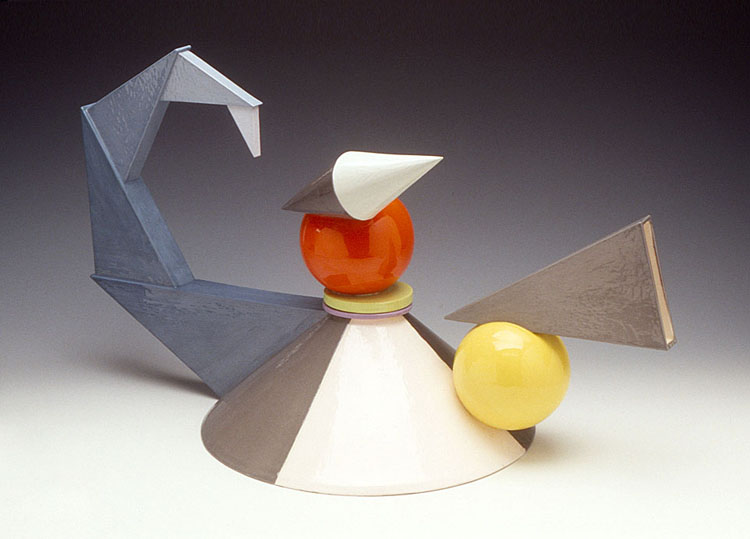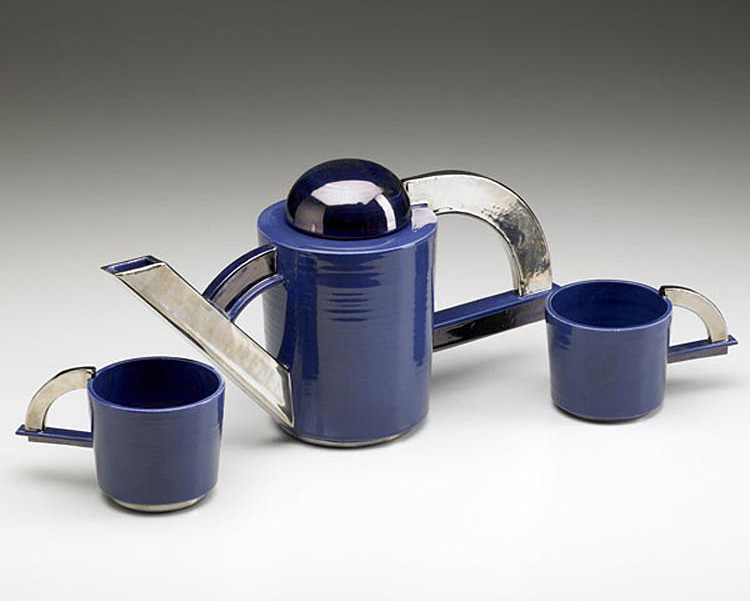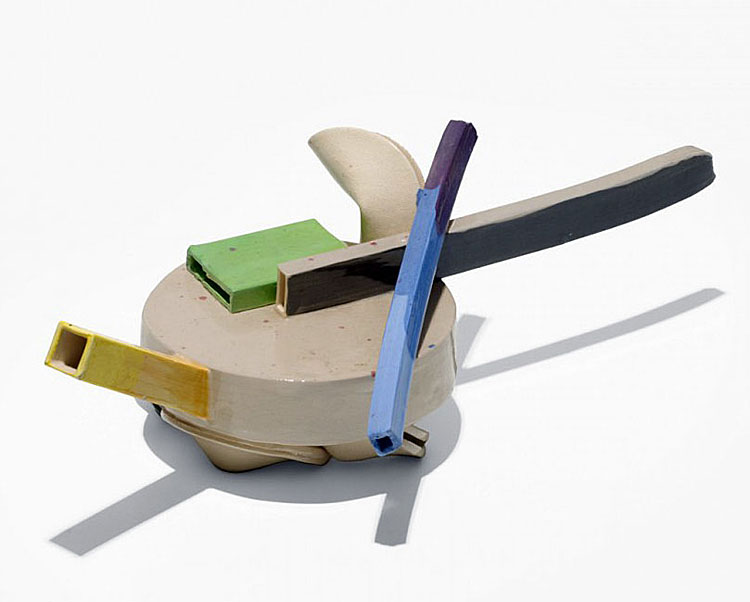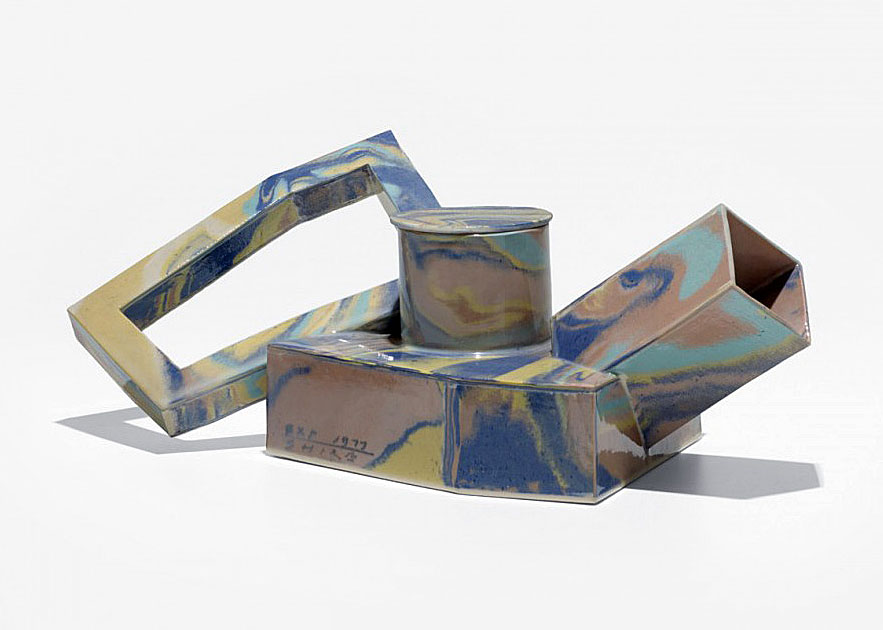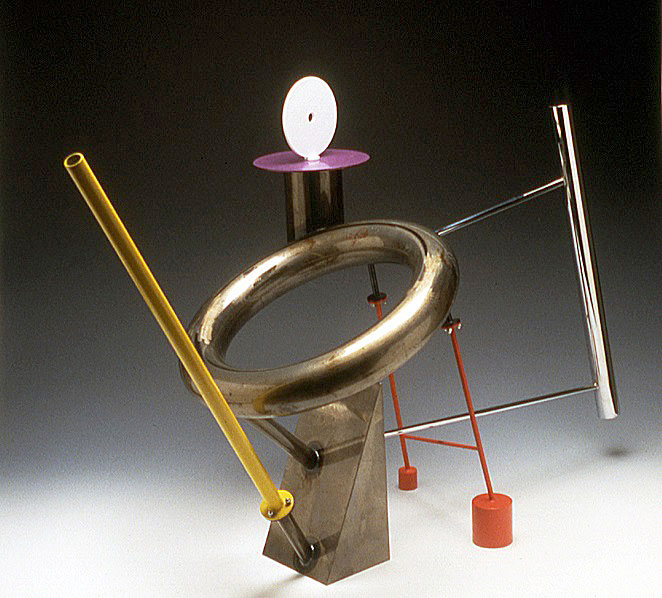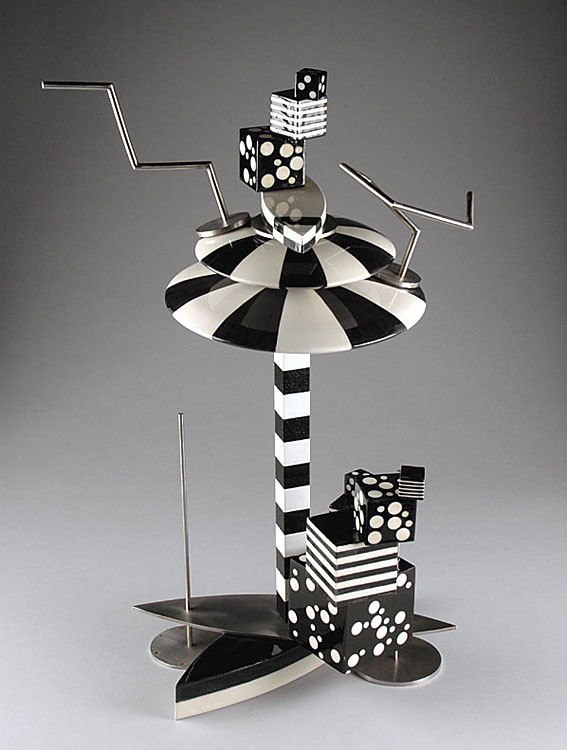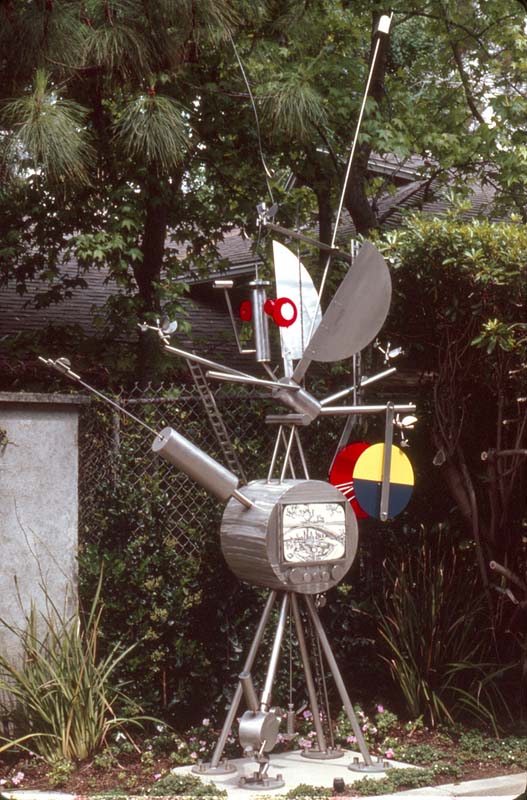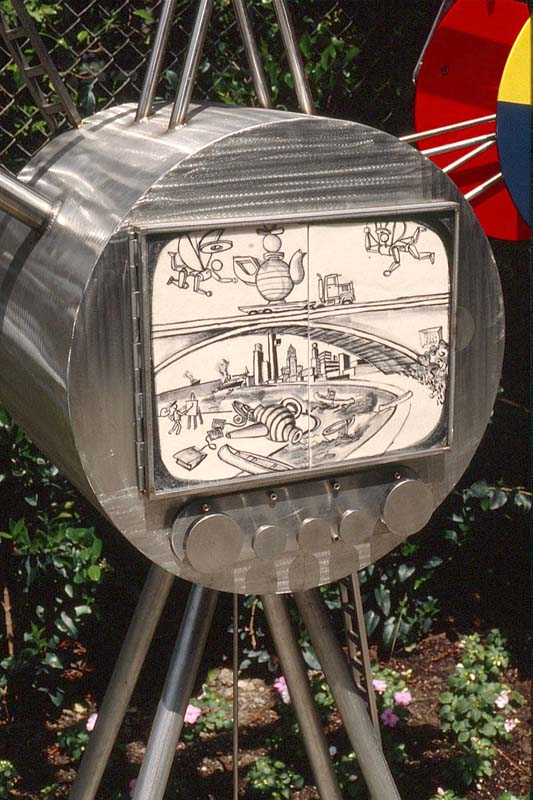“I am a maker of things, a hand-skills guy, so ceramics was my romantic vision. I wanted to be a potter wearing funky sandals and an apron.”[i] – Peter Shire
While this early fantasy of being a “humble potter” might not have come true, the internationally recognized artist Peter Shire (American, b. 1947) has had an enduring love affair with clay.[ii] It has been a favorite medium since junior high. However, as Shire matured as an artist, he ventured beyond the potter’s wheel creating furniture, toys, interior designs, and public sculptures in a range of materials. “Since the 1970s [he] has been working at an intersection,” an intersection “where craft, fine art, and industrial design collide.”[iii] Perhaps this is an acceptable way to describe Shire’s oeuvre since he dislikes categorizations. Instead, he sees “[his] position in the art world” as “extremely mobile because [he includes] and cross[es] over so many boundaries.”[iv]
The Kamm Foundation has ninety-four Shire works in its collection dating from 1972 to the 2000s. This impressive group reflects not only Sonny and Gloria Kamm’s friendship with the artist, but also his distinct visual language that “reference[s] and parod[ies] influences such as the Bauhaus, Futurism, Art Nouveau, and Art Deco.”[v] Over the course of his career, Shire has created objects that are simultaneously colorful, witty, joyful, bold, and imaginative. All these qualities are apparent here as well as his connections to the Memphis design group, of which he was a founding member. Teapots, of course, are the primary focus in the Kamm’s collection. Shire, like the Kamms, has had a long-standing affinity for these vessels.
FOUNDATIONS
Shire was born and grew up in Echo Park, California, a neighborhood northwest of downtown Los Angeles. While he has traveled extensively over the years, he continues to call that area home. In 2011 Shire and his wife Donna even moved into a midcentury modern construction that his parents designed with architect Josef Van der Kar.[vi] Van der Kar was a family friend and, like his parents, an active supporter of the Communist Party. For that reason, Shire often describes himself as a “red-diaper baby.”[vii]
Academics never came easy for Shire. However, the arts were a different matter.[viii] Even in elementary school he describes himself as “clearly one of the art kids.”[ix] This inclination was partly due to his father’s influence. Shire’s father, who studied illustration at the Pratt Institute in Brooklyn, New York, was a master carpenter. He taught his son the “values of making things by hand” and “encouraged” him “to build and tinker.”[x] Shire’s artistic propensities only seemed to strengthen as he got older. By high school, working in clay consumed his time. With the help of his ceramic teacher Anthony Scaccia, Shire was working in clay five hours a day during his senior year. This was combined with night classes taught by Scaccia and Saturdays at the Chouinard Art Institute in Los Angeles.
After high school Shire enrolled at Chouinard to continue his studies in ceramics. Ralph Bacerra, who was chairman of the department, wanted his students to learn “all the fundamentals that a classically trained potter should learn” such as “throwing on the potter’s wheel, glaze calculation, and firing kilns.”[xi] This foundation was instrumental in forming Shire’s artistic voice as was the innovative ceramic work of Ken Price, Peter Voulkos and John Mason.[xii] These individuals “bridged the gap between ‘fine art’ and ‘craft’ through their unprecedented application of contemporary styles to the medium.”[xiii] Shire graduated from Chouinard with a Bachelor of Fine Arts in 1970.[xiv] Two years later he established his first Echo Park studio.[xv]
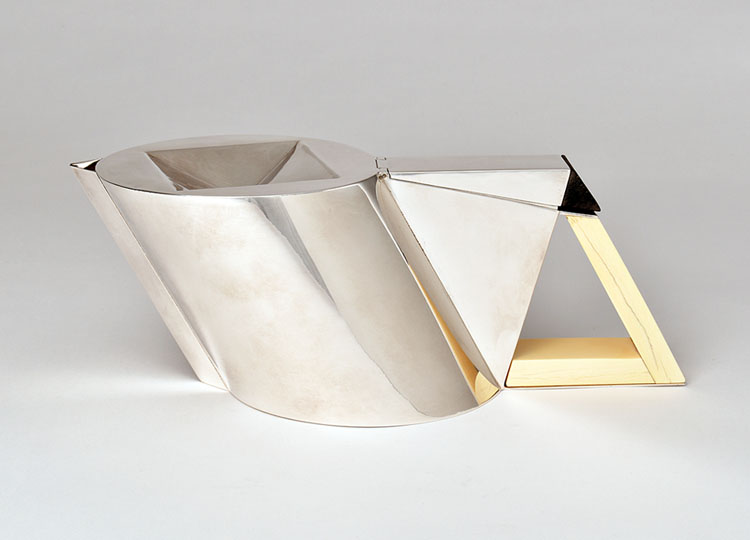
MEMPHIS GROUP
Following graduation Shire’s work “went through a litany of forms” which included traditional pottery made using hand-building or the wheel.[xvi] He discovered that he preferred “a low-fire clay and glaze palette, a combination which allowed for the production of surfaces that could be highly controlled and manipulated.”[xvii] However, in 1974 Shire’s work changed stylistically. “He wanted to introduce the sculptural into teapots, to rearrange the exterior volume.”[xviii] This transformation was inspired by the Bauhaus aesthetic, particularly the metalwork of Marianne Brandt, who combined rounded forms with “industrial angles.”[xix] For Shire, these sculptural teapots reminded him of the haphazard piles of scrap wood at his father’s work sites.[xx] The piles appealed to him visually. Shire has “compare[d] them ‘a constructivist composition where the artist is absent.’”[xxi]
In 1977 Shire’s teapots were featured in the February/March issue of WET Magazine. This article, which was called “TEA,” happened to be seen by the celebrated Italian designer Ettore Sottsass. Sottsass said upon seeing Shire’s teapot “[he] just about fell off [his] chair. [His] ceramics were so new, so right-for-the-moment, so fresh, so witty, and so full of information for the future…”[xxii] Sottsass was also impressed by Shire’s distinctive way of working the clay. Instead of using the potter’s wheel, carving, or relying on coils, he built his constructions out of joined square slabs of semi-hardened clay. Sottsass compared this process of combining these “ceramic planes” and other elements to “building a house of cards.”[xxiii]
In 1979 Sottsass invited Shire to come to Milan, Italy. He wanted to introduce this Californian artist to a group of designers and architects from around the globe who were united in their desire to shake up the design world.[xxiv] They called themselves the Memphis group or Memphis Milano.[xxv] Together they would design postmodern furniture, carpets, fabrics, ceramics, glass, and metal objects “that [were] innovative, forceful, and optimistic.”[xxvi] The aesthetic, with its bold color palette and clashing patterns, pulled from multiple artistic styles and popular culture. It has been described as “way ahead of its time.”[xxvii] Shire became one of the founding members of Memphis and one of the few Americans involved. During this period he designed numerous objects including the Bel Air chair (1982) and the Hollywood coffee table (1983) which have received widespread acclaim. When contemplating Memphis Shire has stated, “we were coming out of industrialism and entering into what is currently called the information age. I see Memphis and the approach to the pieces as a manual attempt at constructing things the way a computer could.”[xxviii]
KAMM COLLECTION
Shire’s work in the Kamm Collection ranges from his ceramic and metal teapots to drawings of teapots and even a commissioned stainless steel, aluminum, and enamel teapot-mailbox called Kamm-o-Mail (2003). As you study the group you can begin to see important aspects of his oeuvre. You see early vessels with concentric circles, that can almost look more like “spinning tops than containers made of clay,” as well as later work inspired by Alexander Calder.[xxix] You also see an ever-present love of strong contrasting colors, forms that reflect the influence of the Bauhaus or even Constructivism, and of course, objects that capture Shire’s whimsical spirit.
Shire has described teapots as “the premiere object. It is the most difficult…the pinnacle, the holy grail of potterdom.” He believes that “there is a romance with tea. Teapots are sort of like teddy bears…They are something that people get instant associations of warmth and coziness.”[xxx] For these reasons, Shire is continually drawn to the teapot form. However, his teapots are distinctive. Shire “eliminate[s] references to the hand, to the small, discreet, and comfortable object. [He] began by making them confrontational, so you’d have a hard time grabbing them.”[xxxi] Shire wants them “…to be more than groovy little constructions.”[xxxii] Furthermore, these asymmetrical combinations of seemingly unrelated elements often trick the eye. You might think this cannot be a tea pouring vessel, but in truth the spout, handle, and body are often there and operational.
There are many teapot configurations that are reoccurring in the Kamm Collection. There are multiple versions of Shire’s signature scorpion-shaped teapots, a group of vessels with alternating black and white stripes, numerous narrow flat-feeling teapots, various metal pieces with elongated tubular extensions, and interestingly, Shire must have an affinity for peaches as the fruit is included in at least three works.[xxxiii] In addition, there are five teapots from his Mexican Bauhaus series that range in date from 1977-2000. With these architectural works Shire “poaches cheekily from [the] Bauhaus and German Werkbund even as it undermines the dictates of those foundational movements…With Shire, form no longer follows function. He revels in the absurdity of the non-functional and the playful.”[xxxiv]
CONCLUSION
While Shire continues to be fascinated with teapots, over the years he has also spent time working on other creative endeavors. For instance, after serving on the design team for the 1984 Olympics, he has been commissioned to design numerous large-scale public artworks primarily in the Los Angeles area.[xxxv] Shire’s work is also featured in numerous prestigious collections such as the Victoria and Albert Museum, London, England, the Smithsonian American Art Museum, Washington, DC, and the Metropolitan Museum of Art, New York, New York. Most recently, in February of 2023, he had a solo presentation at the art fair Frieze Los Angeles. Called Living Room Theater, the exhibit in Jeffrey Deitch’s booth immersed visitors into “Peter Shire’s distinctive artistic world, with sculpture, furniture, drawings, and ceramics.”[xxxvi] For this presentation Shire visualized: “Sunny days and illusions of beaches and fun with occasional rain. Broken planes and flying shapes intersecting and chattering. Constructive, enthusiastic, optimistic…after all, once we say things, they have a chance of becoming real.”[xxxvii]
Further Reading/Viewing:
Chandelier Creative and Autre Magazine. West of Memphis: A Day in Peter Shire’s Studio. 2018.
Israelson, Harry. Peter: On Fishing. 24 June 2018.
Oral History with Peter Shire. Smithsonian Archives of American Art. 18-19 September 2007.
Shire, Peter. Tempest and the Teapot: The Ceramic Art of Peter Shire. New York, NY: Rizzoli International Publications, 1991.
Spieth, Darius A. and Jo Lauria. L.A. to LA Peter Shire. Baton Rouge, LA: Louisiana State University Press, 2013.
Swenson, Eric Minh. Peter Shire Drawings, Impossible Teapots, Furniture, and Sculpture. 18 October 2018.
Notes:

